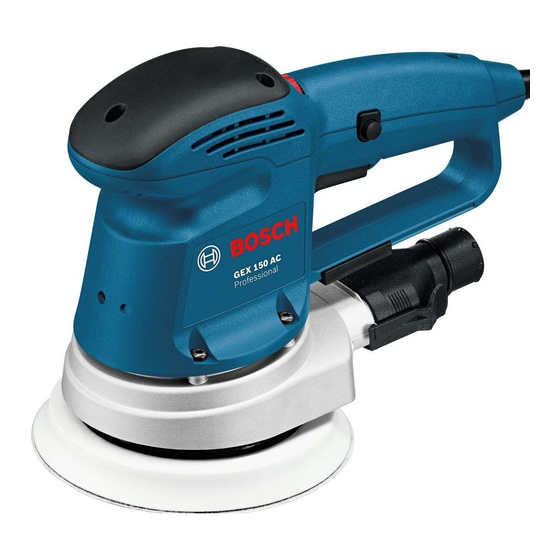- ページ 10
電動工具 Bosch 125 AのPDF オリジナル取扱説明書をオンラインで閲覧またはダウンロードできます。Bosch 125 A 13 ページ。 Gex professional
Bosch 125 A にも: オリジナル取扱説明書 (11 ページ)

The required stroke rate depends on the material
and the working conditions and can be deter-
mined through practical testing.
The constant electronic control keeps the stroke
rate almost constant under no-load or load con-
ditions and ensures a uniform working perform-
ance.
After longer periods of working at low stroke
rate, allow the machine to cool down by running
it for approx. 3 minutes at maximum stroke rate
with no load.
Sanding Plate Brake
An integrated sanding plate brake reduces the
stroke rate when running at no-load so that scor-
ing is prevented when placing the machine onto
the workpiece.
If the no-load stroke rate continuously increases
over the course of time, then the sanding plate is
damaged and must be replaced or the sanding
plate brake is worn. A worn sanding plate brake
must be replaced by an authorised after-sales
service agent for Bosch power tools.
Operating Instructions
Wait until the machine has come to a stand-
still before placing it down.
Sanding Surfaces
Switch the machine on, place it with the com-
plete sanding surface on the surface to be
worked and move the machine with moderate
pressure over the workpiece.
The removal capacity and the sanding pattern are
mainly determined by the selection of the sand-
ing sheet, the preselected orbital stroke rate
(GEX 125 AC/GEX 150 AC) and the applied pres-
sure.
Only flawless sanding sheets achieve good sand-
ing capacity and extend the service life of the ma-
chine.
Pay attention to apply uniform sanding pressure;
this increases the working life of the sanding
sheets.
Bosch Power Tools
Intensifiying the sanding pressure does not lead
to an increase of the sanding capacity, but to in-
creased wear of the machine and the sanding
sheet.
A sanding sheet that has been used for metal
should not be used for other materials.
Use only original Bosch sanding accessories.
Rough Sanding
Attach a sanding sheet with coarse grain.
Apply only light pressure to the machine so that
it runs at a higher stroke rate and high material
removal is achieved.
Fine Sanding
Attach a sanding sheet with fine grain.
By lightly varying the application pressure or
changing the orbital stroke rate
(GEX 125 AC/GEX 150 AC), the sanding plate
stroke rate can be reduced whereby the orbital
action is maintained.
With moderate pressure, move the machine in a
circular pattern or alternately in lengthwise and
crosswise directions over the workpiece. Do not
tilt the machine to avoid sanding through the
workpiece (e. g. when sanding veneer).
After finishing the working procedure, switch the
power tool off.
Polishing (GEX 125 AC/GEX 150 AC)
For the polishing of weathered paint or buffing
out scratches (e. g., acrylic glass), the machine
can be equipped with appropriate polishing ac-
cessories such as lamb's wool bonnet, polishing
felt or sponge (accessories).
Select a low stroke rate (setting 1 – 2) for polish-
ing in order to avoid excessive heating of the sur-
face.
Apply polishing agent crosswise or in a circular
motion with a polishing sponge and moderate
pressure, and then allow it to dry lightly.
Polish the partially dried polishing agent with
crosswise or circular motions using a lamb's
wool polishing bonnet.
English | 21
2 609 932 594 | (14.8.07)
